Gutta percha
Wonder material of the mid-19th century
|

Koehler’s Medicinal Plants, 1887 |
What tropical tree connects telegraphy and golf? The answer to the question
in last month’s Pioneers’ Page is: gutta percha. The name comes from the Malay
language and refers to several species of tree from the genus Palaquium (also
called Isonandra) that are native to Southeast Asia. In Malaysia, the tree is
known as “taban” and people there traditionally used its solidified sap (or
“getah”) to make such items as moulded handles for tools and knives. This
natural latex, also called gutta percha, is the trees’ most valuable product.
And, some 150 years ago, its unique properties allowed a tremendous expansion in
telegraphy — as well as in the game of golf.
The trees that produce gutta percha can grow up to 30 metres tall. They have
glossy, evergreen leaves and white flowers. |
Plastic precursor
While working as Singapore’s chief surgeon, a Briton, William Montgomerie,
came across gutta percha in use by local people. Believing that it would be
valuable for making medical equipment, he sent samples to the Royal Society of
Arts in London, where the substance was exhibited in 1843.
| |

BT Heritage |
Submarine telegraph cables from around 1850: on the far right is the first
cable laid between England and France, a simple wire coated with gutta percha |
Telegraphy beneath the sea
The world’s first, international submarine telegraphic link was constructed
by a retired British antiques dealer, John Watkins Brett. With his engineer
brother Jacob, in 1850 he had a telegraph line laid between Dover in England and
Cap Griz Nez in France. This was simply a copper wire coated in gutta percha
that was so light it had to be weighted in order to sink. After only a day, it
was broken by a fishing boat. However, a second attempt the following year
used a much stronger cable that was designed for the purpose by railway
engineer, Thomas Crampton. This had a double layer of gutta percha, enclosed
within tarred hemp, spun yarn and galvanized iron wire. The telegraphic link
opened on 13th November 1851, and one of its first uses was to transmit Paris
stock prices to London. |
|
|

BT Heritage |
Jacob Brett helped to construct the world’s first international, submarine
telegraph line in 1850 |
|
Gutta percha is a polymer of isoprene that is soft when heated and can easily
be moulded into various shapes that are precisely detailed. When cold, it is
hard, inelastic and durable. These properties made it suitable for a multitude
of uses, from picture frames to buttons, as demonstrated in the Great Exhibition
in London in 1851. In the period before man-made plastics, the answer to easy
manufacture of many goods was gutta percha.
Coating cables
Only four years before gutta percha arrived in London, Charles Wheatstone
(working with William Cooke) had opened the world’s first commercial telegraph
system in 1839 (see Pioneers’ Page for November 2006). He also experimented with
telegraphic links through underwater cables. At the time, telegraph wires were
normally coated with rubber. However, such an elastic material, which also
became brittle when cold, was not ideal for submarine use. Wheatstone confirmed
that gutta percha is an excellent electrical insulator that is well-suited to
the dark, cold, high-pressure depths of the sea — where its insulating
capability actually increases.
| |

Stephen Done/LFC Museum |
The coating of submarine telegraph cables became the main use of gutta
percha, made easier by the invention in 1845 of a device (reportedly based on
Italian pasta machines) that extruded a tube of gutta percha over copper wire.
It is said that within fifty years, about 250 000 nautical miles of submarine
telegraph cable had been laid worldwide, all with cores insulated in gutta
percha. It was not bettered as a material for this purpose until the invention
of polythene in 1933.
Better balls
Golf also benefited from the introduction of gutta percha. The game had been
played for centuries, first with wooden balls and then with ones made from
feather-stuffed hide. The problem was that these hand-made balls were expensive
and could not be used in wet conditions. Gutta percha came to the rescue in
1848, when it was first used for golf balls. These “gutties” could be made
cheaply, and, if they became misshapen, they could easily be softened and
remoulded. Their reliability and cheaper price was an important factor in the
expanding the popularity of golf.
Teeth too
Despite its long history, gutta percha is still in use today. In the same
year that the new type of golf ball appeared, gutta percha was first used in a
compound for filling drilled teeth. Modern dentists continue to use it for
filling root canals. Many of us, it seems, may carry gutta percha in our jaws!
And without it, the mid-nineteenth century communications revolution of
worldwide telegraphy might never have begun.
Question for next time:
This year has seen the 200th anniversary of the birth of Isambard Kingdom
Brunel in 1806, and marks 150 years since the foundation of the Atlantic
Telegraph Company. How does this flagpole in Liverpool link the two?
The answer
appears in the next edition of Pioneers’ Page.
|
|


